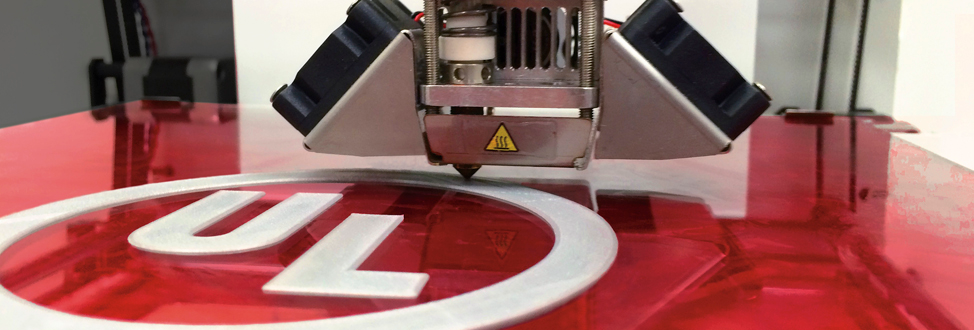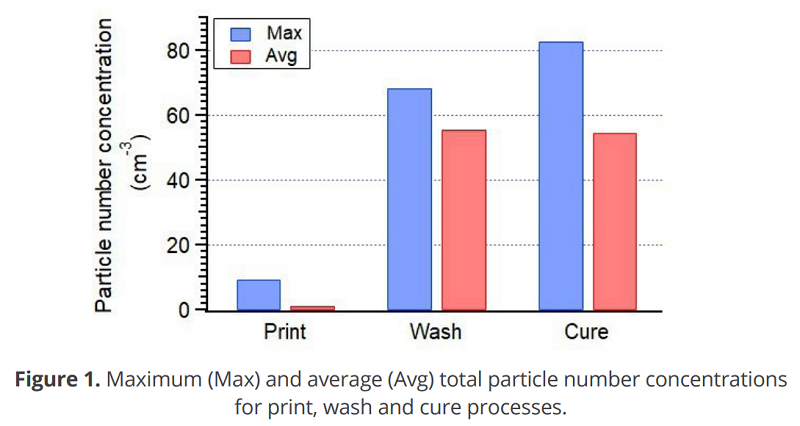In 2018, Chemical Insights, an institute of safety science company Underwriters Laboratories, released a study about the safety and health impact of 3D printing, which found that emissions released into the air during FFF printing included a lot of unhealthy, ultrafine particles (UFPs) and volatile organic compounds, or VOCs. Now, it’s come out with a follow-up to the original 2018 study, and what it reveals may surprise you.
Together with its research partners, the Georgia Institute of Technology’s School of Civil and Environmental Engineering and School of Earth and Atmospheric Sciences has been researching the characterization, and potential health and safety impacts, of 3D printer chemical and particle emissions for several years, even publishing a consensus standard that included toxicity responses and laid out 3D printing emissions criteria and test protocols.
Taking a different tack than the 2018 publication, this new summary report, “Particle and Chemical Emissions from a Vat Photopolymerization 3D Printer,” focuses on SLA (resin) 3D printing, which uses photochemical processes and UV light to fabricate objects and is also known as vat photopolymerization.
“This report presents the preliminary findings of particle and chemical emissions from a desktop SLA 3D printer during printing, as well as associated post-processing treatments, in accordance with ANSI/CAN/UL 2904.1 Emissions from SLA 3D printing are compared to previously obtained results from FFF 3D printing using the same testing method,” UL researchers Qian Zhang, PhD, and Marilyn Black, PhD, wrote.
The researchers took emission measurements for the study in an airtight, 1 m3 exposure chamber, with an enclosed SLA 3D printer, loaded with a clear resin, placed inside. Accessible ports with gloves on the sides of the chambers allowed the researchers to operate the printer without opening it or changing the air conditions within. The printer was heated to 31°C before the four-hour print job began, and post-processing included a wash and cure process that took a total of 25 minutes; the lid was only open when the print was being loaded and unloaded.
An optical particle sizer and a scanning mobility particle sizer spectrometer were used to measure various particles, and the particle emission rate and yield during 3D printing and post-processing were processed per ANSI/CAN/UL 2904 methods.
“VOCs as well as formaldehyde and other low-molecular weight carbonyl compounds were collected onto sorbent media separately, and then analyzed by gas chromatography – mass spectrometric or high performance liquid chromatography, respectively,” the researchers explained. “Sampling time (i.e., target sampling volume) was adjusted according to the chemical levels in the chamber during printing and the shorter processing time for post-processing treatments.”
The preliminary findings from this study showed that, while there were limited UFP emissions, VOC emissions were pretty high. In fact, because of the difference in materials and 3D processes, the researchers found that the total VOC emission rates from SLA 3D printing were higher than FFF 3D printing by a factor of 3 to 6.
In terms of the particle emissions from SLA 3D printing, there was a high similarity to “the levels of the chamber background concentrations.” When compared to the maximum particle number concentration of 103-105 cm3 for FFF 3D printing, the number was below 100 cm3 with the same chamber conditions.
The figure below shows both the total VOC (TVOC) emission rates and the TVOC data statistics from 32 tests with thermoplastics in the previous study related to FFF 3D printing. As you can see, all emission rates were less than the highest criterion allowed by ANSI/CAN/UL 2904, which is 10.4 mg/h.
They detected 40 individual VOCs resulting from 3D printing, 34 from post-process washing, and 42 from post-process curing. The five chemicals with the highest emission rates from these processes, which include isopropanol, hydroxypropyl methacrylate, and various other alcohols, esters, and hydrocarbons, make up 88%, 100%, and 91%, respectively, of “the sum of VOC emissions for print, wash and cure processes.”
“These highly emitted chemicals from SLA 3D printing (Figure 3) were not commonly observed from previously studied FFF 3D printing. Only BHT (2,6-di-tert-butyl-4-methylphenol) was detected at a frequency of 15% among 39 FFF prints, while the rest of the VOCs listed in Figure 3 had less than 10% detect frequencies. Among the top 10 individual VOCs detected from SLA 3D printing, 1-butanol was detected with a frequency of 72% for FFF prints, and the rest were below 50% detect frequency,” the researchers wrote.
The first study found that the VOC emissions resulting from FFF 3D printing were associated more with the filament, which is why the most common ones from that study were either detected at low rates or not detected at all in this study on SLA 3D printing.
A VOC that’s listed in health-related regulation and guidance is known as a chemical of concern, and multiple chemicals of concern were detected:
- 17 from the print process
- 16 from the wash process
- 12 from the cure process
One of these, the human carcinogen formaldehyde, was actually found in all three processes at emission rates of 0.01 mg/h or less; others include acetaldehyde from the 3D printing and naphthalene from washing.
All told, while the emission rates and approximate office exposure levels for these chemicals of concern were lower than specified guidance and regulations, the total mixture of all the acrylates, alcohols, and aldehydes found in the SLA emissions could, as the researchers state, “present a strong irritation response among those exposed.”
“Since these studies demonstrate the potential for adverse human health effects, research is continuing to further assess toxicity of emissions and to evaluate options for reducing emission exposures,” the researchers concluded.
If you’re interested in detailed emission results, you can check out the full study here.
Subscribe to Our Email Newsletter
Stay up-to-date on all the latest news from the 3D printing industry and receive information and offers from third party vendors.
Print Services
Upload your 3D Models and get them printed quickly and efficiently.
You May Also Like
3D Printing News Briefs, June 11, 2025: Sustainability, Automotive Tooling, & More
We’re starting with sustainability news in today’s 3D Printing News Briefs, as EOS has strengthened its commitment on climate responsibility, and Zestep is making 3D printing filament out of eyewear...
3D Printing 50 Polymer Stand-In Parts for Tokamaks at the PPPL & Elytt Energy
Of all the world’s things, a tokamak is one of the hardest, most complex, expensive and exacting ones to make. These fusion energy devices make plasma, and use magnets to...
3D Printing News Briefs, May 17, 2025: Color-Changing Materials, Humanoid Robot, & More
We’re covering research innovations in today’s 3D Printing News Briefs! First, Penn Engineering developed 3D printed materials that change color under stress, and UC Berkeley researchers created an open source,...
Firehawk Aerospace Partners with JuggerBot 3D, Gets $1.25M from AFWERX for 3D Printed Propellants
Texas-based Firehawk Aerospace, an advanced energetic materials firm that works with aerospace and defense applications, announced a strategic partnership with JuggerBot 3D, an Ohio-based large-format 3D printer manufacturer. Together, the...






































